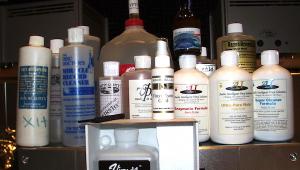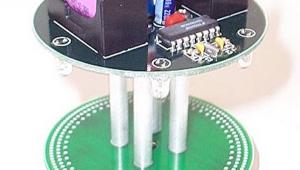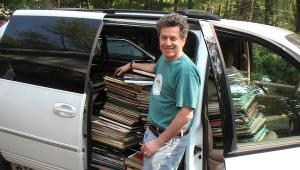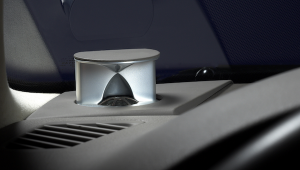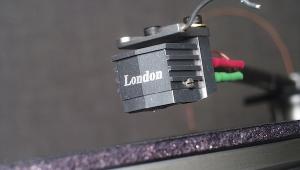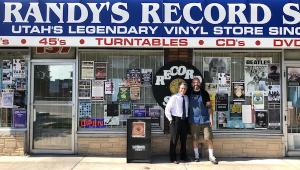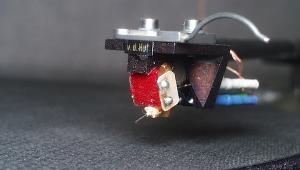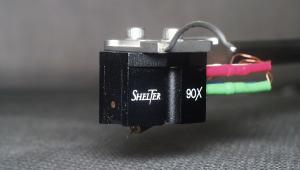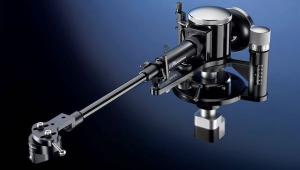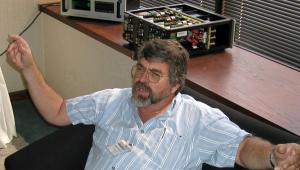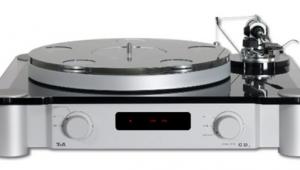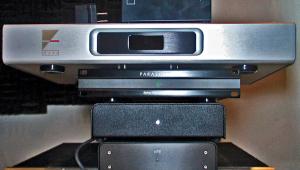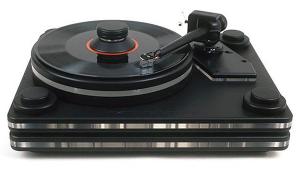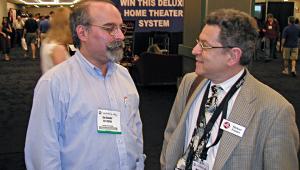Analog Corner #87

Carr's feverish polishing, using Flitz metal-cleaner paste (www.flitz.com), Caig DeOxit, and special cloths he'd brought from Japan, is best described in another column because it might take another column. But it transformed the sound of my system and, literally, the look and feel of the AC plug blades. When Carr was done, I almost needed sunglasses to cut the glare from the satiny-smooth blades.
"Pretty amazing, isn't it?" Carr smirked knowingly.
"Had he been really motivated," Carr's Scan-Tech partner Stig Bjorge assured me, "he would have cut the power and cleaned the AC receptacles as well!" Meanwhile, I'd gone to the Flitz website and ordered a tube of the stuff for myself.
But Carr and Bjorge hadn't traveled halfway around the world from Japan just to dust my electrical broom. They'd come to install the Connoisseur Definition 4.0 line- and phono-stage preamplifiers, and Carr wanted to be sure I'd hear them (and my reference) under the best conditions. Sold in Japan since August 2000, the handbuilt units have been available for export only since late 2001. Though they're the "step-down" versions of the Model 3.0 combo, built to order for about $60,000 apiece, the Definitions' price of admission is still steep at $29,000. (That's for the combo of $16k line and $15k phono. If you buy the single version, take $1000 off the price.) I put "step-down" in quotes because Carr assured me that while the 4.0 is not the equal of the 3.0, the combo does include circuit upgrades not found in the 3.0. The 4.0's amplifier circuit was designed by Petr Mares; Carr is credited for the regulator circuitry, printed circuit board layout, and overall direction, Jim Sweeney for the cabinet, and Yoshinori Sasaki for the chassis.
Like the Boulder 2008/2010 line-/phono-stage combo I reviewed in the July 2002 issue, the Connoisseur Definition 4.0 really deserves a full Stereophile review. But I'm booked many months in advance, and as the Definitions became available on very short notice, I'm covering them here and now.
Based on an Instant Classic
Almost a decade ago, I heard Petr Mares' extraordinary Connoisseur 2.0 phono section in my system. It was so much more revealing, transparent, dynamic, detailed, and rhythmically expressive than the very best I'd heard up to that point that it instantly defined for me the state of the phono-section art. Until recently, its sonic performance hadn't come close to being equaled, let alone surpassed, and with so few units in the field and the fever-pitch word of mouth, the 2.0 became an almost legendary instant classic.
The problem with the 2.0's wooden cabinet was its "air dielectric" construction, which eschewed traditional circuit-board architecture in favor of miniature, hand-wired, impossibly complex three-dimensional circuit construction. The idea was to keep signal paths as short as possible, and to eliminate the noise and coloration caused by stray capacitance, parasitic induction, and leakage currents of standard circuit-board traces. But while the results were undeniable, there was no way the amp could be reliably built in quantity, so when Mares Designs was incorporated into Bjorge and Carr's Scan-Tech of Tokyo, the design was modified. But it's still handbuilt, and it's still very hard to make.
Both the phono and line sections use "sandwiched" air-dielectric circuit boards in which the signal-path components are mounted to and through the boards. This allows them to be soldered to the board below, which contains multiple voltage regulators (48 in the phono section, 24 in the line stage) and other DC circuitry. Each regulator is thus less than 1cm away from the part of the circuit it controls. Imagine the near-impossibility of getting every lead to match up with the tiny hole in the board below. The circuit design includes servo-corrected DC amps and a JFET-based, class-A, distortion-canceling hybrid output stage. The claimed bandwidths are 3–4MHz for the phono section, 7MHz for the line amp.
Both versions use the same substantial outboard power supply and both are no-frills designs aimed, of course, at connoisseurs. The phono section, featuring dual pairs of 36dB-gain boards, offers no external loading or gain options. It's a plug-and-play design set at 47k ohms with a high 70dB of gain (other factory-set loading options are available). The line section sports four single-ended RCA inputs, two balanced XLRs, and a single concentric knob with an outer source-selector ring and an inner volume control that's a handmade stepped attenuator. There are no Tape Out jacks or Mono button.
The Connoisseur Definitions are products for the audiophile in search of ultra-simplicity and ultra-high-quality performance and design. Like their input and switching facilities, the Definitions' superbly finished, curvaceous wooden cases will not float everyone's bar of Lifebuoy, but they did mine. The workmanship and subtle design of the line stage's concentric controls include a dual-mono, 24-pole stepped attenuator using leadless, noninductive, custom-made metal-foil resistors, and were exceptionally pleasing to eye and hand. My only beef was with the integral spikes: they'll scratch wood surfaces, and probably many others. I put lead-rosin Walker Audio Valid Point discs under the spikes to keep from defacing the solid-maple shelves of the Finite Elemente Pagode stand on which I placed both units.
Never Follow a Kid or Animal Act: the Boulder 2008
An old show-biz adage warns against hitting the boards directly after animal or kid performers. In our arena, phono preamps would best avoid being inserted into any system containing a Boulder 2008 ($29,000). Next to the Boulder, the Connoisseur Definition 4.0 is, in most ways, the best phono section I've heard, but the overall difference between the two was still significant. Take every good thing I wrote in July about the Boulder's ability to declare the musical event, add it to the Connoisseur's presentation, subtract a large part of the Boulder's delivery of the musical event's aftermath and ultimate meaning (don't try to measure this!), and you have the sound of the Connoisseur.
I began with both phono sections connected to the Hovland HP-100 preamp, and it was easy enough to switch back and forth to hear the difference. Perhaps it had something to do with the Boulder's 1000 ohm default moving-coil loading vs the Connoisseur's wide-open 47k ohms, but the latter should have had the advantage: For most of my listening, I used both with a Lyra Helikon SL (0.25mV) phono cartridge and a prototype top-of-the-line Lyra Titan (0.5mV).
Both phono sections could "slow time" and convey the gravity of musical events while at the same time sounding incredibly agile and light on their feet, delivering musical transients that were naturally sharp but not etched or smeared, and both were musically organized and temporally coherent as are few other phono sections. They parted musical ways when it came to image dimensionality, resolution of ultra-low-level ambient cues, and harmonic richness. The Boulder produced three-dimensional images that blossomed, ripened, and decayed with impossible precision, while the Connoisseur's images seemed to burst excitedly, leaving less in the wake of the event when compared to the Boulder—though when compared to most other phono sections, the Connoisseur's performance in this regard was stellar.
The Boulder had an amazing ability to balance lifelike image precision with delivery of the musical event and the space in which that image occurred. The Connoisseur did an equally good job on the event while falling short on the space—but only when compared to the Boulder. The Connoisseur made most other phono sections sound soft, confused, sluggish, and distant. That's how good it was, and how exceptional the Boulder is.
Sometimes I have to drag out the old chestnuts to cement my observations. I pulled out Classic Records' 45rpm reissue of RCA Living Stereo's Belafonte at Carnegie Hall and compared "Matilda." With this superbly recorded track I can judge dynamics, spatiality, image specificity and dimensionality, soundstage expansiveness, transparency, depth, you name it.
In Carnegie Hall a few weeks ago, I watched and listened to Patricia Barber and Cassandra Wilson, but part of the time, as I sat there soaking in the room's acoustic, it was Belafonte who was on my mind. Back at home, both the Boulder and the Connoisseur allowed me to suspend disbelief and step back in time 45 years to relive Belafonte's performance, not as a canned recording but as a living entity occurring in real time.
To experience this, the physicality of the hall—the air, space, and boundaries—has to open up before you. The clusters of musicians on the stage have to appear in 3D, as does the image of Belafonte walking across the stage and from front to back; the audience has to be "seen," heard, and felt—in the orchestra seats, the dress circle, the upper tiers. The driving rhythms must be presented with a spontaneity that incites surprise, even after 1000 playings.
Both the Boulder and Connoisseur pulled this off by "stopping time" while propelling the music forward with tremendous rhythmic authority, coherence, and continuity. I don't know how this is done, or why these two phono sections did it so well, but they did. And both did the "build and destroy" trick I described in the Boulder review, creating solid, monumental images without etch or zip. But the Boulder does it somewhat better by carving rounder, more nuanced images that decay and fade away with a more natural grandeur, and by being a bit less brash on top.
The brass, in particular, struck me as more dimensional, dynamic, and convincing through the Boulder. The dynamic contours ebbed and flowed with greater ease, and there was less stiffness and chop. The Boulder delivered the events at the front and back of the stage, and the audience front and back, with eye- and ear-popping accuracy. The Connoisseur excelled at reproducing events occurring at the front of the stage and the part of the audience closest to it, but seemed to drop away the sonic subtext faster—but only compared to the Boulder.
That said, if you forget about the Boulder—and at $29k, that's not too difficult to do—the Connoisseur 4.0 phono section, at about half the price but with none of the Boulder's setup flexibility, delivered a large portion (don't ask me for a percentage) of the Boulder's performance, but with more gain and noise. I had to crank the Connoisseur much higher than I'd ever listen, and only then could I hear background noise with no signal. The unit never intruded on the music, no matter how loud or soft I played the music (using the higher-output Lyra Titan cartridge). However, its noise floor is still lurking down there, and perhaps that affected the Connoisseur's ability to retrieve and resolve ultra-low-level detail—at least in comparison to the Boulder.
But that's mere speculation. The minimal specs provided with the Connoisseur didn't include signal/noise ratio. Cranked all the way up, the Boulder was very quiet by comparison. I wouldn't use a very-low-output (0.25mV) cartridge like the Helikon SL with the Connoisseur because of the noise, but then I have to wonder why the designers bothered to offer 70dB of gain in the first place.
What I find fascinating is how opposite approaches end up in the same sonic terrain. The designers of the Connoisseur strove for simplicity and the shortest possible signal paths. The Boulder is as complex—some might say unwieldy—a design as you're likely to see in a phono section, and yet both achieve a rare level of purity, coherence, harmonic integrity, three-dimensionality, and focus, as well as overall musical grip and immediacy. If you're lucky enough to hear a Connoisseur, you'll know you're hearing something special.
For my final comparison, I listened twice to an original British Decca ffss pressing of Beethoven's Piano Concerto 2 with Ashkenazy, Solti, and the CSO, recorded in May 1972 by the great Kenneth Wilkinson in the Krannert Center at the University of Illinois (SXLG 6594-7). This is a superb recording, especially of the piano. The perspective is decidedly mid-hall, which can create all sorts of problems for the piano's image specificity and overall clarity, but Wilkinson managed to pop the instrument into perfect focus as an appropriately sized image, while capturing the tactile, palpable, percussive sensation of the hammers striking the wires and the sounding board's complex harmonic response, as well as the reverberation throughout the hall.
It's a most convincing piano recording, and it takes a truly great phono section to sort it all out. Both of these did a stunning job, but again, the Boulder's rendering of the piano is simply more nuanced and believable, harmonically and in terms of focus and, especially, its ability to deliver low-level transient detail and decay. Yet without the incomparable Boulder comparison, the Connoisseur provided one of the most compelling renderings of this recording that I've heard.
Connoisseur Definition 4.0 line amplifier & The Combination
Swapping out the Hovland HP-100 for the Connoisseur Definition 4.0 line amp provided a major jolt. Going from tubes to solid-state will do that. Most changed were bass lines, which became faster and much firmer. The 4.0 really whipped the Avanti III woofers into line, while leaving the rest of the picture lush and rich, though with an overall emphasis much different than the Hovland's. The increased bass solidity extended all the way up the frequency line, giving images more body. Overall dynamics were also upped, and the entire presentation seemed to accelerate, producing an exciting, energized picture that was more to the front of the stage than the Hovland's, but without ever sounding like "hi-fi" or intruding on the music with sonic games.
The most memorable aspect of this combination was its overall coherence. The picture was cut from whole cloth, leaving no loose or dangling edges. And, as with the Boulder 2010, there wasn't a hint of transistoritis, grain, or etch.
Which line-stage sound you might prefer is a matter of taste and associated gear. I was surprised by the difference; when going from the Hovland to the Boulder 2010 line stage, I hadn't noted as abrupt a change. I don't know what that means, exactly, in terms of which is "better," especially because I couldn't compare the two directly.
Immediacy, excitement, solidity, organization, rhythmic drive—the combination of Connoisseur line and phono stages was a formidable performer that, with the right cartridge, amplifier, and speakers, will provide musical thrills galore without adding etch, grain, or any of the other supposed solid-state "baddies." The combo produced a clarity and sense of musical purpose second in my experience only to the Boulder twins. However, some might find it too organized and punchy compared to live music, though I think that response will be system-dependent. Not a combination for those who want phono-section flexibility (or who use very-low-output moving-coil cartridges) and a tape loop, and the sound will probably not appeal to the single-ended-triode and Lowther crowd, or to tube lovers in general.
But I loved my time with the idiosyncratic, minimalist Connoisseur 4.0 combo. It is among the finest front-ends I've heard. Both models are worth considering as separates, if you can live within their limitations—and, of course, afford them.
Spray on Premièr! Lift Off Vinyl Corns!
Some of you probably thought I was nuts to recommend that steam machine for cleaning LPs a few issues back. A friend brought over "Before" and "After" photos of an LP that had gotten wet and whose surface was now plastered with bits of paper inner sleeve and glue. A few steam sprays, a light brushing with the included attachment, and a vacuuming took care of it quickly. Good as new.
In other record-cleaning news, I was recently sent a can of Premièr! aerosol spray-on record cleaner from Micro Care (www.microcare.com). The company makes solvents for the electronics and aerospace industries (their stuff is used on the Space Shuttle), and an audiophile named Tom Lyle somehow discovered that their Contact Cleaner C works really swell on LPs. In the old days, Freon-based cleaners were often used by audiophiles to clean records. Both Nitty Gritty and LAST marketed such products, but with the discovery of a so-called dangerous hole in the ozone layer supposedly caused by CFCs (refrigerants used in air-conditioning and refrigeration), Freon was forced off the market by self-appointed liberal activists and so-called "science experts." Next they'll try to pin so-called "global warming" on carbon dioxide and ban that too. Give me a break. These pink types point to Alaska, but everyone knows Alaska is falling into the ocean because the oil we should be drilling there is backing up and over-lubricating the glaciers, causing them to flow faster into the sea.
Micro Care's Premièr! can be used to clean LPs, CDs, and DVDs, among other things. It uses DuPont's Vertrel CF, which doesn't cause a hole in the ozone layer. You're supposed to "briskly" spray across the LP surface, then brush in a circular motion around the grooves. Premièr! is claimed to be "plastic-safe," so I gave it whirl with the most expensive record in my collection (ha-ha). The product is said to have unusually low surface tension and high specific gravity, so it flows easily in and through the grooves, dissolving oils and fingerprints and, especially, mold-release compounds. It then dries quickly, leaving no residue. A perfect product to use with the Orbitrac. Vacuum re-cleaning is suggested for "exceptional" results.
I took a used a fairly dirty Nina Simone album I'd picked up recently, Wild is the Wind (Philips PHS 600-207), and gave it a spray followed by an Orbitracing. It ended up looking very clean and shiny, with no residue whatsoever. But the proof is in the playing. There was still some noise, which a subsequent vacuuming did not remove. But most important, after that first play the stylus remained clean, with no residue or dirt stuck to it.
My verdict: Premièr! is very useful, especially with questionable records you want to audition without bothering to vacuum them. You can spray and wipe such a record in a few seconds, and then play it. If it turns out to be trashed, chuck it. Otherwise, you can vacuum it or, in some cases, leave it as is. Quickly and easily getting rid of mold-release on new LPs without vacuuming would be another use. A can of Premièr! should last a long time, but use it in a well-ventilated room—I felt a bit weird after using it. But then, I felt weird before using it.
Sidebar: In Heavy Rotation
1) The Stooges, The Stooges, Elektra/Sundazed 180gm reissue LP
2) David Bowie, Heathen, ISO/Sony LP
3) Hank Mobley, Hank Mobley, Blue Note/Classic 200gm Quiex SV-P mono reissue LP
4) Curtis Mayfield, Curtis in Chicago Live!, Get Back 180gm reissue LP
5) Nick Drake, Time Has Told Me (home recordings & outtakes), 180gm LPs (3)
6) Nina Nastasia, The Blackened Air, Touch and Go 180gm LP
7) Gary Wilson, You Think You Really Know Me, Motel LP
8) Mary Tiimony, The Golden Dove, Matador 180gm LP
9) Uncle Tupelo, 89/93, An Anthology, Columbia/Legacy/Sundazed 180gm LPs (2)
10) Varèse, Amériques, Vanguard/Classic 180gm reissue LP
